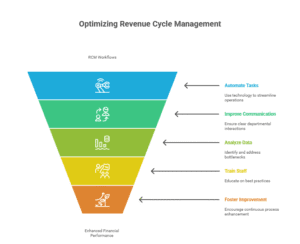On-Demand Outsourcing BPO Services for Healthcare Providers With 24/7 Coverage!
Save up to 70% on staffing costs!
Browse Specialty Staffing ServicesRCM Workflow Optimization Strategies in Hospitals

As healthcare systems face rising costs and increasing administrative burdens, optimizing Revenue Cycle Management (RCM) workflows has become a critical priority for hospitals. RCM encompasses the entire process of managing patient revenue—from registration to final payment—and inefficiencies at any stage can result in significant financial losses, delayed payments, and patient dissatisfaction. By strategically refining each component of the workflow, hospitals can boost operational performance, improve cash flow, and enhance overall care delivery.
Key Areas of the RCM Workflow
Before exploring optimization strategies, it’s essential to understand the core stages of a hospital’s RCM process:
Patient Registration and Insurance Verification
Eligibility Checks and Authorizations
Medical Documentation and Coding
Claims Creation and Submission
Denial Management and Appeals
Payment Posting and Reconciliation
Patient Billing and Collections
Each of these steps involves administrative staff, clinical documentation, and payer interactions—making process coordination vital.
Strategies for Optimizing RCM Workflows
1. Automate Front-End Processes
Automating registration, eligibility checks, and prior authorizations reduces manual errors, accelerates scheduling, and ensures insurance coverage is verified before services are rendered.
Tools to use: Real-time eligibility software, self-service patient portals, pre-registration systems.
2. Implement Clinical Documentation Improvement (CDI) Programs
Inaccurate or incomplete documentation leads to coding errors and claim denials. CDI programs promote better communication between providers and coders, ensuring records support accurate billing.
Benefits: Increased case mix index (CMI), improved coding quality, better audit outcomes.
3. Use Predictive Analytics for Denial Prevention
Leverage historical data to identify patterns in claim rejections. Machine learning models can flag risky claims before submission, allowing staff to intervene proactively.
Outcome: Higher first-pass resolution rates and reduced rework.
4. Streamline Coding and Billing Systems
Centralize your coding operations using Computer-Assisted Coding (CAC) tools and integrated EHRs. Ensure coders are up to date on ICD-10/CPT updates to avoid costly mistakes.
Action Step: Schedule regular coder training and audits.
5. Enhance Denial Management Workflows
Rather than treating denials reactively, optimize with real-time dashboards, automated appeal generators, and denial reason analytics.
Metrics to track: Days in A/R, denial rate, appeal success rate.
6. Improve Patient Financial Engagement
Transparent, user-friendly billing improves collections and reduces confusion. Offer cost estimators, digital statements, and flexible payment options.
Tools: Mobile payment platforms, automated reminders, chatbots.
7. Ensure Regulatory Compliance
Incorporate HIPAA and payer-specific rules into every system. Use role-based access, encryption, and audit trails to protect patient data.
Key Focus: Compliance monitoring during claims handling and patient communications.
8. Regularly Audit and Benchmark Performance
Establish KPIs and benchmark performance across departments. Identify bottlenecks and reassign resources or redesign workflows accordingly.
KPIs to monitor: Clean claim rate, collection rate, average days to collect, coding accuracy.
Benefits of RCM Workflow Optimization
Faster reimbursements and improved cash flow
Lower administrative costs
Fewer claim denials and write-offs
Higher patient satisfaction
Improved compliance and audit readiness
What Did We Learn?
Hospitals that invest in RCM workflow optimization are better positioned to thrive financially and operationally in today’s challenging healthcare environment. By combining technology, staff training, and data-driven insights, healthcare leaders can build resilient, efficient revenue cycles that support both clinical excellence and financial sustainability.
What People Are Asking?
1. What is RCM workflow optimization?
It’s the process of improving revenue cycle steps like billing, coding, and collections to increase efficiency and reduce payment delays.
2. Why is RCM optimization important for hospitals?
It boosts cash flow, minimizes claim denials, reduces administrative costs, and improves patient satisfaction.
3. How can automation help in RCM workflows?
Automation speeds up tasks like insurance verification, claim submission, and patient billing while reducing manual errors.
4. What are key tools used in optimizing RCM?
Common tools include eligibility check software, CAC systems, analytics dashboards, and patient billing portals.
5. How do hospitals measure RCM performance?
By tracking KPIs like clean claim rate, days in A/R, denial rates, and collection percentage.
Disclaimer
For informational purposes only; not applicable to specific situations.
For tailored support and professional services,
Please contact Staffingly, Inc. at (800) 489-5877
Email : support@staffingly.com.
About This Blog : This Blog is brought to you by Staffingly, Inc., a trusted name in healthcare outsourcing. The team of skilled healthcare specialists and content creators is dedicated to improving the quality and efficiency of healthcare services. The team passionate about sharing knowledge through insightful articles, blogs, and other educational resources.
 Book a Demo to Build Your Team Today!
Book a Demo to Build Your Team Today!


 Read Case Studies
Read Case Studies 


 Virtual Medical Assistants
Virtual Medical Assistants



